Wisconsin may be best known as America’s Dairyland to those outside the state. Their thoughts may also turn to the breweries of Milwaukee. While Wisconsinites do indeed produce some delicious cheddar and brew some serious beer, that only scratches the surface of what the state has to offer.
For gardeners, the climate in the Badger State can present challenges. Winter temperatures are known to dip as low as -35°F in the coldest regions. The yearly average temperature for the state is 55°F, but locally in the colder zones, the annual average can remain below 40°F.
Obviously, Wisconsin residents aren’t growing tropical flowers in their gardens, but these cool temperatures are actually a boon to other flowers. And there is no better example than springtime’s most popular flower, the tulip.
Ranging from Zones 3b-5b, the plant hardiness zones of Wisconsin are prime for tulip production. So let’s talk Wisconsin tulips!
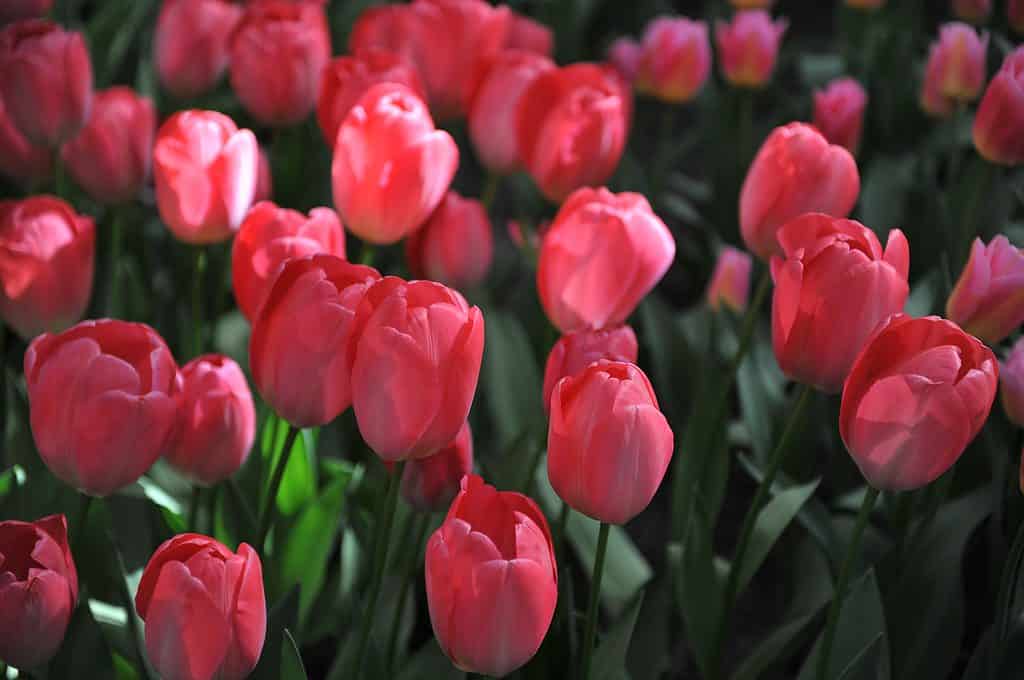
Pink Van Eijk Tulips with dark green foliage.
©Sergey V Kalyakin/Shutterstock.com
Get to Know the Tulip
The Tulipa genus includes around 150 species with over 3,000 cultivars. They are divided into 15 different classifications based on shape, height, and when they bloom.
| Tulip Facts | |
|---|---|
| Botanical name | Tulipa spp. |
| Common Name | Tulip |
| Plant Type | Perennial, bulb |
| Sunlight | Full |
| Soil | Rich, well-drained |
| Bloom Season | Spring |
| Toxicity | Toxic to both humans and pets |
Types
With so many tulip types and cultivars, things can become a bit overwhelming for gardeners. So let’s narrow it down. Which tulips will thrive in the cool Wisconsin climate? This is not an exhaustive list by any means, but here are five excellent tulip choices for Wisconsinites.
1. Red Emperor Tulip
The Emperor tulip group (also known as Fosteriana tulips) is among the hardiest of all tulips, making them a perfect choice for even the very coldest regions of Wisconsin.
The Red Emperor is a member of the Emperor group. (It is also sometimes called the Madame Lefeber tulip.) Growing tall with its large tomato-red blossoms, this Emperor will certainly give your tulip bed a regal, majestic look.
On clear days, the sun will coax petals to open, revealing a dark black heart. The blossoms will close to their trademark urn shape when the skies are cloudy.
Recommended for growing in Zones 3-8, the Red Emperor can thrive throughout the Badger State. And if this specific variety isn’t available, many other types of Fosteriana tulips will grow beautifully in Wisconsin.

Red Emperor Tulips blooming in a flowerbed.
©pr2is/Shutterstock.com
2. Heart’s Delight Tulip
This stunning tulip is part of the Kaufmanniana tulip group (also known as the Waterlily tulip group). Kaufmanniana tulips feature short stems topped with large, showy blooms, and the Heart’s Delight is certainly a standout member of this group.
The blooms are endlessly interesting, with pink/red hues blending with a creamy white on the outside of the petals and a pale pink interior with a bright yellow heart. The mottled foliage adds yet another layer of visual interest.
Rated for growing in Zones 3-8, the Heart’s Delight can do exactly what its name suggests. It can delight the hearts of Wisconsinite gardeners from Superior to Madison and everywhere in between.
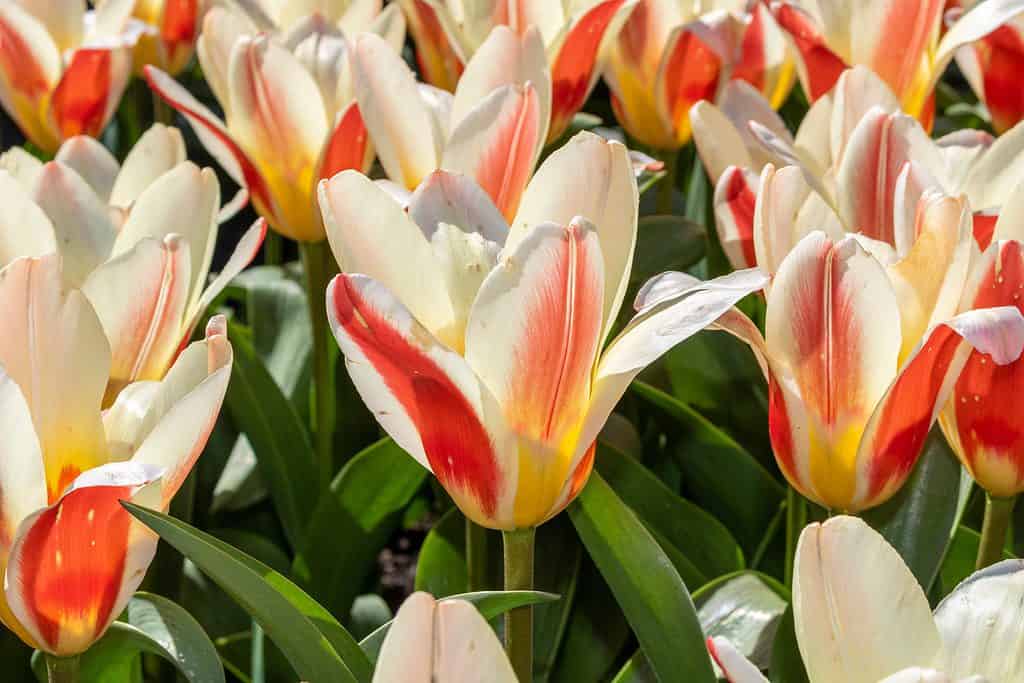
Numerous Heart’s Delight Tulips with pink and creamy white petals.
©Irenestev/Shutterstock.com
3. Toronto Tulip
The Toronto is a member of the Greigii Tulip group. Greigiis are known for their cold hardiness and also for their extended blooming period. When you grow Greigii Tulips in your garden, you’ll have lots of color for a long time.
The Toronto Tulip features a bright orange-red bloom with mottled foliage. And here’s a wonderful bonus: it is a multi-flowering tulip. One bulb can produce three to five flowers! If you’re a value-conscious gardener, you’ll get a lot of bang for your buck when you purchase Toronto bulbs.
Another tulip that is recommended for Zones 3-8, all Badger State growers can enjoy this beauty next spring.

Bright orange-red Toronto Tulips with fully open blooms.
©Andrianova Tanya/Shutterstock.com
4. Marilyn Tulip
Tulips in the Lily-Flowered group are known for their slender petals that are usually pointed and recurved (curved backward). The Marilyn variety is a gorgeous member of this group, with its pink-red flames accenting the ivory-white petals. The tulip opens fully in the sun, showcasing its unique bloom structure and colors.
If there is a drawback to the Marilyn tulip, it is that its stem is less sturdy than other tulip varieties. It is susceptible to wind damage, and the wind can certainly whip through Wisconsin in the spring. But if you have an area that is somewhat protected from strong winds, the Marilyn tulip will make your spring display sing!
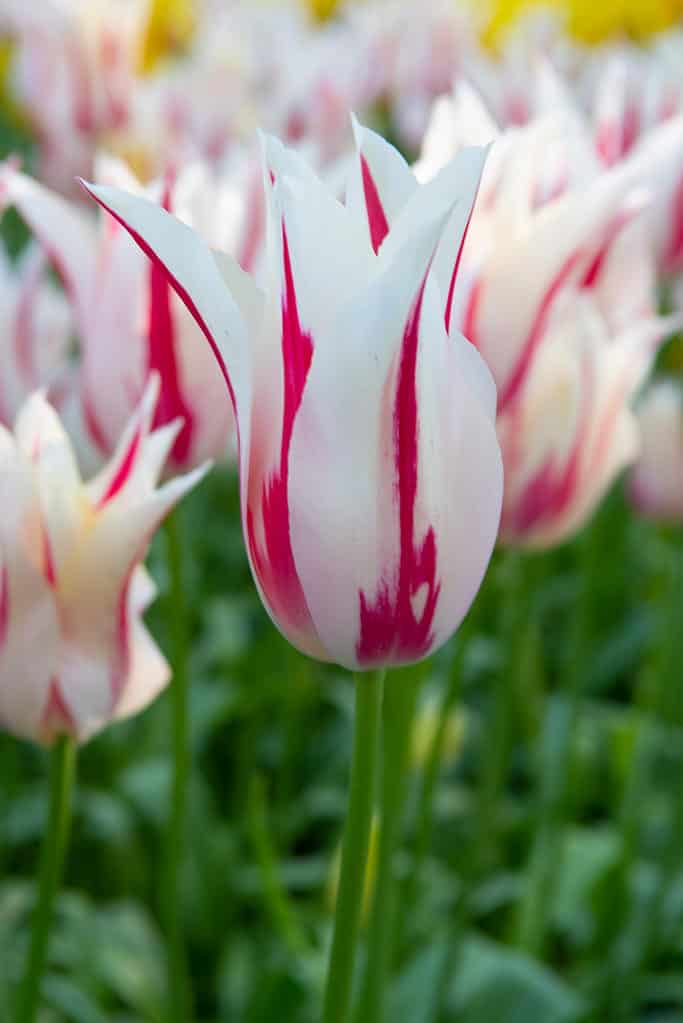
Marilyn Tulips with ivory petals accented with pink-red flames.
©InfoFlowersPlants/Shutterstock.com
5. Van Eijk Tulip
This variety is part of the Darwin Hybrid Tulip group. Darwin Hybrids are widely known for their tall, sturdy stems that, unlike Lily-Flowered tulips, can certainly stand up to the elements. The Van Eijk Tulip can really hold its ground during the unpredictable weather of a Wisconsin spring.
This tulip features a large, cup-shaped bloom that is a lovely coral pink, accented with hues of apricot and darker pink. Rated for Zones 3-8, this gorgeous pink tulip has a place in any Wisconsin flowerbed.
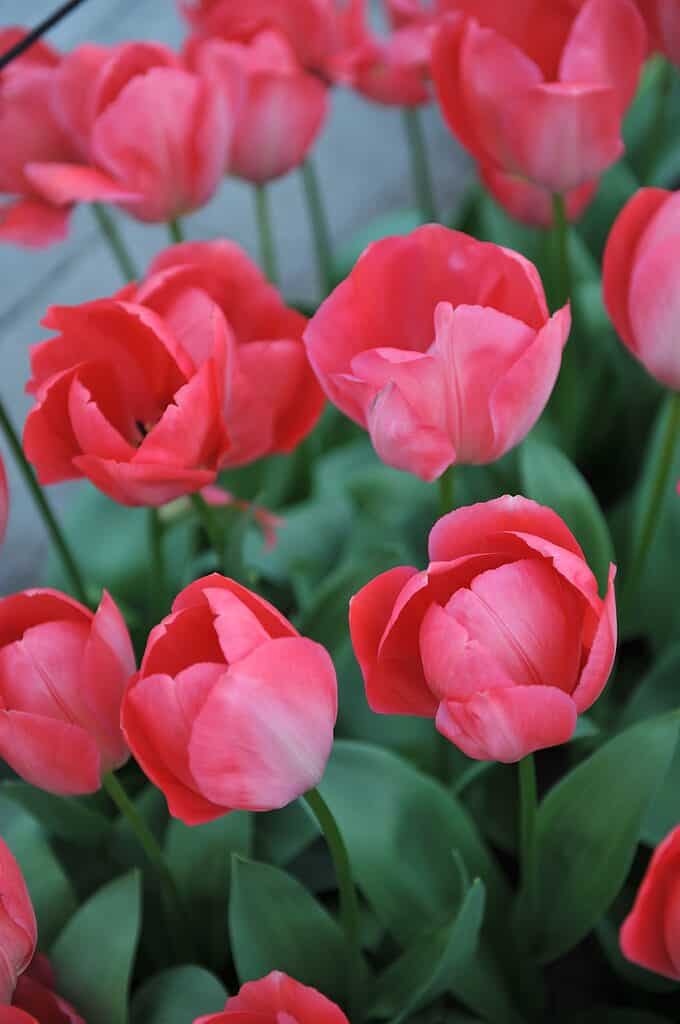
Pink Van Eijk tulips blooming in a garden.
©Sergey V Kalyakin/Shutterstock.com
Planting Tips
To reiterate, this is by no means an exhaustive list of tulips that will thrive in Wisconsin, But now that you have a few different varieties in mind, let’s explore some tips and best practices to help you grow a tulip display that will make all your neighbors jealous next spring.
Bulb Selection
The tulip is a spring flower, but its success or failure will actually be determined during the preceding autumn. That’s when tulip bulbs are planted, and the decisions made during this time will make all the difference between a lackluster or an eye-popping spring display.
Planting healthy bulbs is key because, quite simply, healthy bulbs grow into healthy flowers. When preparing for the bulb-planting season, choose bulbs that are firm and dry, not soft and squishy. If a bulb has mold spots or discolorations, discard it.
Quality tulip bulbs are beige-white with a papery outer jacket. And larger bulbs are a better choice, as they have a greater store of nutrients.
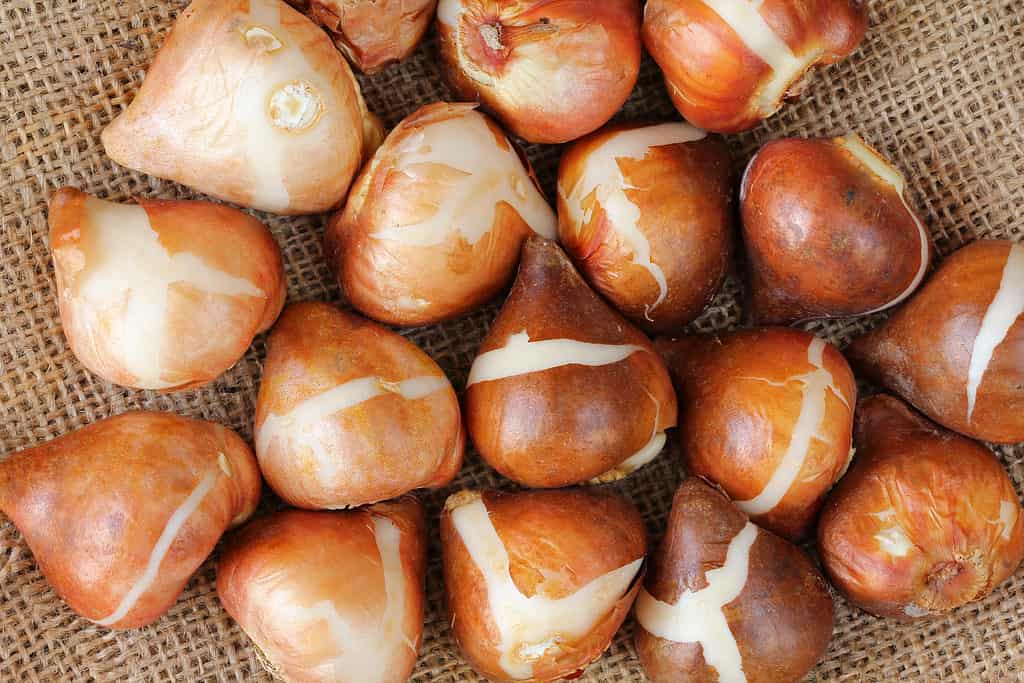
Healthy tulip bulbs with light brown papery skin.
©sasimoto/Shutterstock.com
When to Plant
Tulip bulbs are cold-hardy, meaning they must experience an extended cold stratification period to emerge from dormancy. The bulbs won’t break dormancy without these cold conditions, and the tulips will not grow.
It’s best practice to plant tulip bulbs when the soil temperature dips below 55°F.
For northern Wisconsin gardeners in Zone 3, plan on planting your tulip bulbs in September or October.
The remainder of the state is in Zones 4-5, where the ideal time to plant tulip bulbs is October-early November.
These are only general guidelines, of course. Check the soil temperature in your locality to determine the prime time to put those bulbs in the ground.
Where to Plant
When considering placement, remember that tulips need to soak up the sun. So a spot that receives six hours of sunlight a day is ideal. You’ll also need to ensure that the area drains well. If it’s prone to standing water, the tulip bulbs could rot.
Some growers like to give their tulips a little extra help by adding some fertilizer. A slow-release fertilizer with a nutrient ratio of 9-9-6 is recommended.
If you’d rather use an organic mix, you can use equal parts greensand, blood meal, and bone meal.
Plant the bulbs with the pointed side up about 8-10 inches deep and spaced 3-4 inches apart.
Perennial Tulips
Tulips are perennials, but they are rather persnickety perennials. Many growers struggle in helping their tulips bloom well after the first season. One common reason for this problem is placement.
Growers often use the same space for spring bulbs and summer annuals. The problem is that many summer flowers require lots and lots of watering. Just because the tulip bulbs are underground and out of sight through the summer doesn’t mean this doesn’t affect them. All that summer watering can rot the bulbs.
Tulips (and all other bulbs) do best when they are planted in their own area, away from summer flowers. If you’re tight on space and all your different flowers must share the same area, try growing low-maintenance summer flowers that need less water. That can help protect your bulbs from rotting.
It’s worth noting, though, that even in ideal conditions, tulips are not the easiest flowers to perennialize. The brightest, strongest blooms are almost certain to appear in the first spring. The results are likely to lessen significantly in subsequent seasons.
For this reason, many gardeners don’t even attempt to perennialize tulips. Instead, they dig up the flowers after the growing season and plant new bulbs in the fall.
When in Bloom
When tulips first break through the ground in the spring, those young flowers are met with a whole host of wild and changing weather conditions, especially in places like Wisconsin.
What do you do if you believe your tulips have started growing too soon? Maybe there’s been a string of warmer, sunny days where your tulips are peeking through the ground, but you know a strong cold snap is coming. Should you cover the young flowers or take some other steps to protect them? Actually, no.
Tulips are hardy, meaning they can handle the unpredictable weather of a Wisconsin spring. In fact, many well-intentioned growers actually harm their plants by covering them.
While exceptions may be made in cases of extreme cold, the most helpful thing you can do for your tulips while they are growing is nothing at all. Those hardy bulbs will show you just how hardy they are!
Toxicity
Tulip bulbs contain alkaloid and glycoside compounds that are mildly toxic to humans and moderately toxic to pets.
Gardening gloves are highly recommended when handling bulbs or blooms to prevent “tulip fingers,” a skin rash well-known to tulip growers.
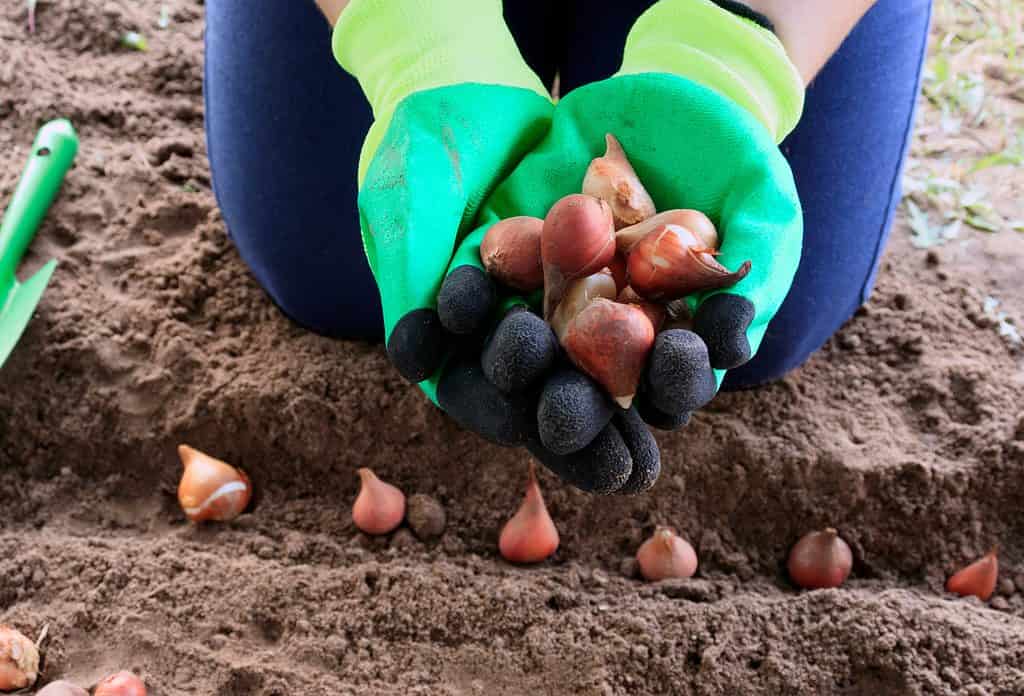
Tulip bulbs in a gardener’s gloved hands.
©Natallia Ustsinava/Shutterstock.com
Common Pests
Aphids
Tulips attract many pests. One of the most common is the aphid.
Aphids suck the juices out of the tulip plant. When large numbers of aphids are present, they can severely damage or even destroy tulips.
Small aphid infestations can be treated by dipping a cotton swab in rubbing alcohol and applying it directly to the insects.
For more significant aphid problems, spraying insecticidal soap on the plants is effective and eco-friendly.
Wildlife Problems
Wildlife also poses a threat to your tulip garden.
Squirrels and chipmunks are plentiful in Wisconsin, and they love to dig up freshly-planted tulip bulbs in the fall. As recommended above, planting at a deeper depth can deter these rodents.
The eastern cottontail rabbit also proliferates in the state. Rabbits are more of a springtime nuisance for tulip growers, as they love to munch on the tender tulip shoots when they first break through the soil’s surface.
White-tail deer can also wreak havoc on your flowerbeds. When tulips begin to grow, deer will pull them out of the ground, bulb and all.
While it likely won’t stop all rabbits and deer from tiptoeing through your tulips, a commercial repellent can be effective at slowing them down significantly.
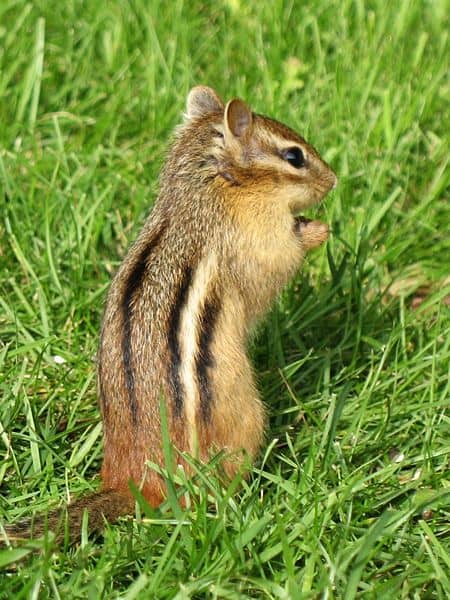
Chipmunk in green grass.
©Gilles Gonthier, CC BY 2.0, via Wikimedia Commons – License
Final Thoughts
When people think of Wisconsin, they will always think of cheese and beer. But the state’s brilliant spring tulip displays should also come to mind because it’s one of the most prolific tulip-growing regions that you’ll ever find!
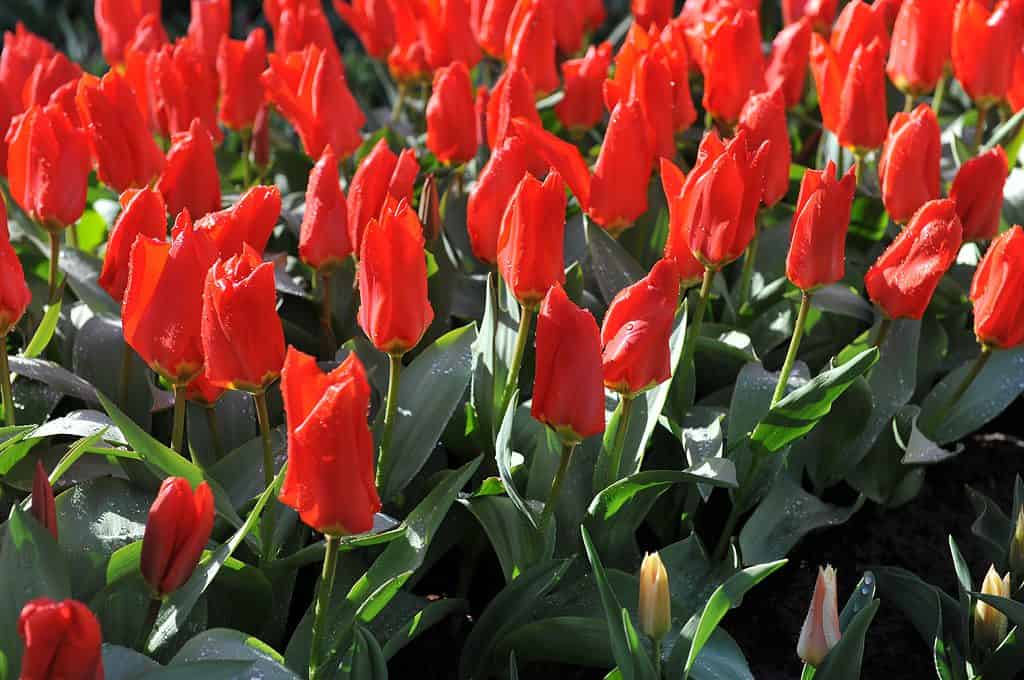
Garden filled with blooming Red Emperor Tulips.
©Sergey V Kalyakin/Shutterstock.com
The photo featured at the top of this post is © Sergey Rybin/Shutterstock.com
Thank you for reading! Have some feedback for us? Contact the AZ Animals editorial team.






